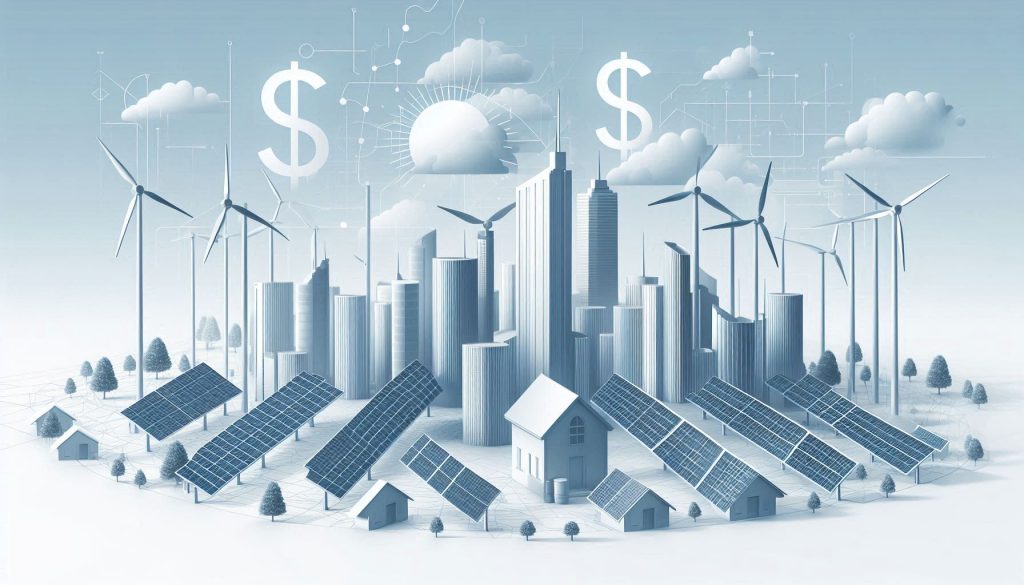Embracing renewable energy is not merely a trend; it’s a pivotal move towards a sustainable future. As the world confronts the pressing challenges of climate change and diminishing fossil fuel reserves, the United States offers a fertile ground for investment in sustainable power solutions. For those seeking to align their financial ventures with environmental wellness, delving into the realm of renewable resources presents a compelling opportunity.
This pathway not only bolsters ecological preservation but also ensures potential lucrative returns. By scrutinizing market trends and technological advances, investors can strategically position themselves to benefit from the Capital’s shift towards clean and sustainable energy sources.
Comparing renewable power opportunities

The market for alternative energy is teeming with opportunities, and investors keen on sustainable ventures are spoiled for choice. To make informed decisions, understanding the different kinds of power solutions is crucial. Solar and wind remain the frontrunners, with hydropower and geothermal creeping slowly into the spotlight. Each of these sources has distinct characteristics that cater to varied investment strategies and risk appetites.
Solar energy’s appeal lies in its accessibility and technological advancement. It harnesses the power of the sun through photovoltaic panels and solar farms, which have seen a drastic reduction in production costs over the years. Wind power, on the other hand, captures kinetic energy through turbines and is particularly effective in areas with consistent wind patterns.
As these technologies advance, the cost of generating power continues to decline, enhancing profit margins for investors. Geothermal and hydropower, although less widespread, cater to niche markets with specific geographical benefits. By understanding these dynamics, investors can select the sector that best aligns with their financial goals.
The role of technology and innovation
Technological advancements play a pivotal role in transforming the landscape of sustainable energy. Innovations have led to efficiency gains and cost-reductions across various renewable sectors. For instance, breakthroughs in solar panel efficiency and the development of more durable materials have significantly decreased the costs of capturing and utilizing solar energy.
Similarly, the enhanced design of wind turbines has led to better energy capture even in low-wind areas, making wind farms increasingly viable in diverse regions. Innovations in battery storage have also been crucial in overcoming intermittent supply challenges associated with some renewable sources. Electrical storage technologies, from lithium-ion batteries to emerging solid-state solutions, are vital for maintaining a stable power supply and harnessing the full potential of intermittent power sources.
For investors, staying abreast of these technological trends can provide a competitive edge. By investing in companies at the forefront of innovation, investors can potentially maximize returns while supporting transformative solutions. Adopting such technologies ensures a more stable investment and positive environmental impact.
Policy support and incentives
Government policies and incentives in the U.S. are instrumental for investors eyeing renewable power ventures. These policies include tax credits, grants, and rebates that lower the financial burden of investing in sustainable solutions. The federal government, along with various state authorities, has implemented schemes to promote the adoption and expansion of clean technologies.
For instance, the Solar Investment Tax Credit (ITC) significantly reduces the cost of solar energy installations. Similar incentives are available for wind, hydropower, and other alternatively powered projects, further stimulating investment in these sectors. Additionally, certain states offer specific initiatives, such as net metering laws that allow solar users to sell excess energy back to the grid, thereby increasing their economic return.
The future potential of renewable investments
Looking at the horizon, the future for sustainable power investments shines exceptionally bright. The growing recognition of climate action’s necessity has galvanized public and private sectors to inject substantial resources into renewable infrastructure projects. As demand for clean solutions grows, so does the fiscal opportunity for those ready to seize it.
Institutional investors, smaller funds, and private individuals are increasingly interested in sustainable ventures, tempted by favorable policy environments, advancing technologies, and a global commitment to reducing carbon footprints. These factors translate into a swelling market with numerous entry points that cater to different investment sizes and scopes.
Furthermore, as global and domestic pressure mounts to reduce fossil fuel reliance, renewable projects are carving out a more significant role within the broader energy landscape. Those investing in this transition now are likely to see sustainable financial and social returns. This trend solidifies the renewable sector’s standing as an attractive investment option.
Adapting to changing markets
The renewable power market is constantly evolving, necessitating flexibility and adaptability from investors. Keeping an eye on market trends and consumer needs is essential for those who want their ventures to flourish. For example, growing public awareness of carbon footprints is fueling demand for greener technologies, leading to a proliferation of eco-friendly products and services.
Investors can capitalize on these shifts by responding to consumer preferences and adjusting their strategies to accommodate new developments. One strategy is diversifying portfolios with eco-conscious companies that not only promise financial returns but also align with societal values. Additionally, continual evaluation of venture risks and rewards ensures that investments remain viable and profitable amid dynamic market changes.
